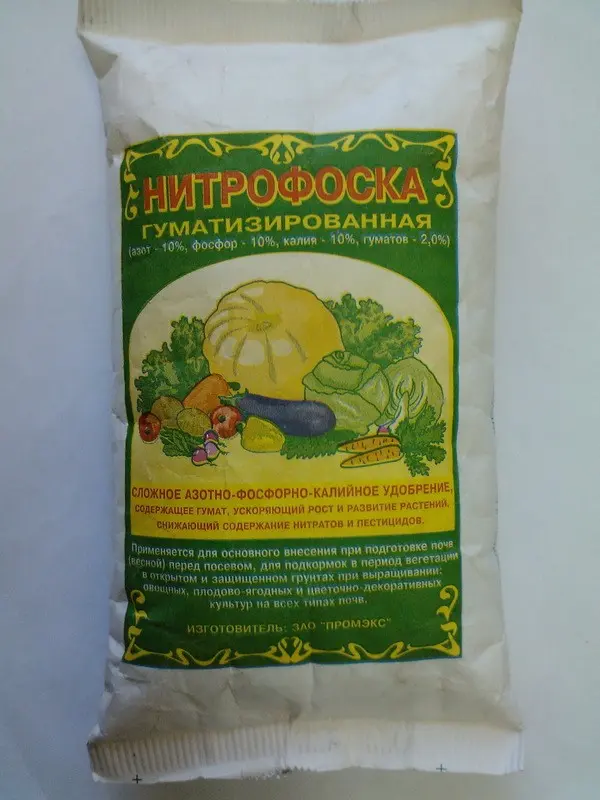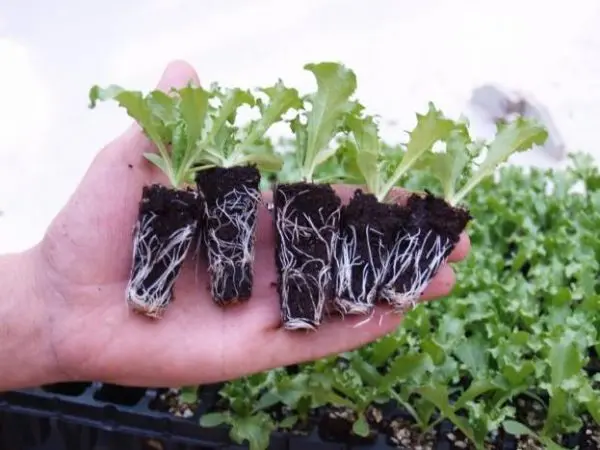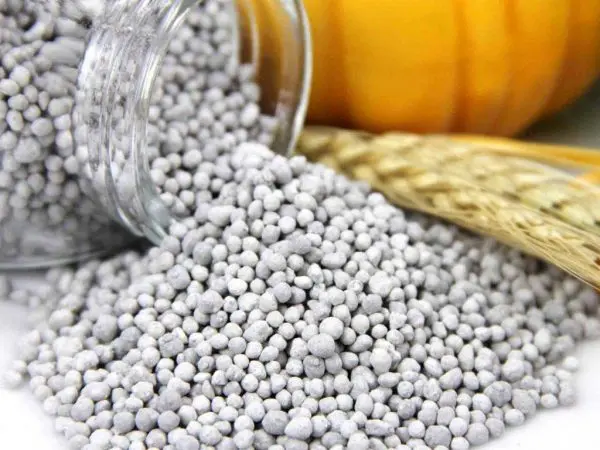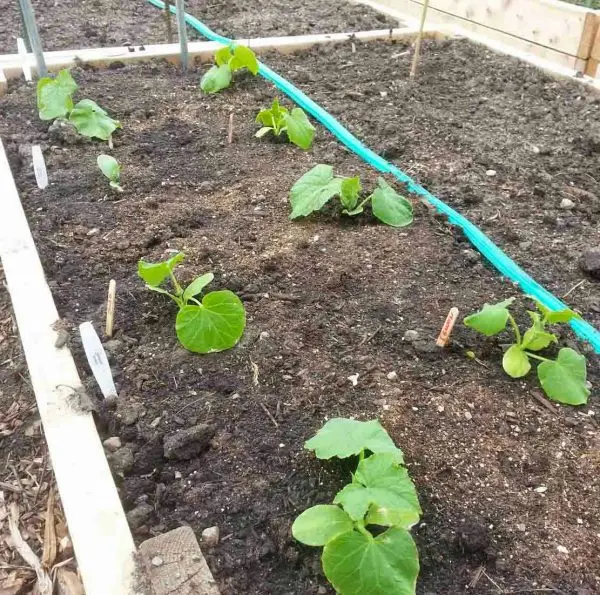Contents
Complex mineral fertilizers have long established themselves as a useful additive in growing vegetables and horticulture. They can be applied dry or diluted according to the instructions. The correct use of fertilizers during planting, for feeding seedlings and at the beginning of fruiting allows you to increase productivity by 15-20% and achieve better crop quality.
Fertilizer description
Nitrophoska is a complex mineral fertilizer, which includes nitrogen, potassium and phosphorus. It is produced industrially from apatites or phosphorites, after their interaction with acids and the addition of several more components. Sold in the form of granules of a light shade, with a diameter of 5-6 mm. Packed in 1, 2 or 3 kilograms in polyethylene or triple paper bags, it is well stored in dry, cool and ventilated areas. It can be used for fertilizing almost all agricultural and cultivated plants, with laying in the soil during autumn or spring digging or directly at planting, or with additional fertilizing, in the form of granules or solution.

What is included in the
The composition of the fertilizer includes nitrogen, phosphorus and potassium, usually in equal proportions, and not less than 10-11% of each trace element. Nitrogen is found in the form of ammonium chloride and ammonium nitrate. Phosphorus – in the form of superphosphate and precipitate. Potassium nitrate provides two trace elements – potassium and nitrogen. Ammophos – phosphorus and nitrogen. Also, the composition of the fertilizer includes calcium-containing salts and compounds. If sulfuric acid was used in the production and the finished fertilizer contains sulfur, it is well suited for cucumbers and beans.
A fertilizer with a high content of potassium and sulfates is good for ornamental plants. Nitroammophoska with additional phosphorus compounds is ideal for tomatoes and other nightshade crops. Also on sale is nitrophoska with additional magnesium content. With the usual action of nitrophoska on plants, nitrogen is first absorbed and allows you to increase the green mass, then, when fruit set begins, phosphorus, which gives a good dense tissue structure, and a little later, when the fruits enter the phase of active growth, potassium, which has a positive effect on taste .
Video “Which fertilizer is better to choose”
How to choose fertilizers for various fruit plants.
Instructions for use
Application is possible on all types of soils and under all crops, the exact dosage should be found in the instructions. Digging the garden in the fall, you can close up 70-90 grams per square meter. If the soil is heavy, then fertilizer should be poured deep.
If the soil is sandy or sandy, then there is a danger that nitrogen components will quickly be washed out of the soil. Therefore, on such soils, nitrophoska is applied during spring digging or directly during planting. Fertilizing fruit trees and shrubs should be done in the spring. Apple trees are fed after flowering – 50 grams of fertilizer must be dissolved in 10 liters of water. Up to 25-30 liters of solution is applied under each tree; for a large tree, the amount of solution can be increased.

If the weather is rainy, then the granules are brought into the soil by digging. And vice versa, dry soil before top dressing should be watered with plain water – so as not to burn the roots. If the seedling is planted in good garden soil, then additional feeding is not needed before fruiting begins. Similarly, you can apply fertilizer for pear trees, although they are more useful than nitroammophoska. For stone fruits, you need to choose nitroammophoska or apply nitrophoska in lower concentrations.
Under the cherry bush, also after flowering, no more than 200 grams of nitrophoska is applied, in the form of granules or a solution. Under gooseberries or currants – up to 100-150 grams. Under raspberries – 60 grams per square meter. You can also feed garden strawberries – add a few granules in the hole when planting, or 30 grams (2 tablespoons) per 10 liters of water – and up to half a liter of this solution for each bush at the end of flowering.

The general application rates for nitrophoska for garden crops are up to 70-80 grams per square meter during spring digging, or for each plant according to its own rates during planting (first feeding). Additional feeding during the season – in the first half of the season, before the start of active fruiting – up to 30-40 grams. Very fond of nitrophoska, especially phosphorite, tomatoes. If the quality of seedlings leaves much to be desired, then the first top dressing can be carried out even before planting in open ground, after picking. To feed seedlings, take 15 grams of fertilizer and dissolve in a liter of water. This concentrate can be used for 40-50 seedling bushes. When planting seedlings, up to 15 grams of granules can be added to each hole by mixing them with the ground.
Or water the planted seedlings by dissolving 50 grams of nitrophoska in 10 liters of water. Two weeks after planting, this top dressing is recommended to be repeated. Bulgarian pepper is fed with nitroammophos or nitrophoska in the first feeding (when planting seedlings or, if the seeds were sown immediately into the ground, then at the stage of the third or fourth shoot). Eggplants can be fed with a solution of 20 grams of nitrophoska per 10 liters of water, two weeks after planting seedlings in the ground.

For potatoes, nitrophoska can be applied during autumn digging or directly during planting – 1 spoonful of granules per hole, mix well with the ground, make sure that the granules do not come into contact with the planting tubers. For cucumbers, fertilizer is used before sowing in the soil or at the first top dressing – at the time the first ovaries appear, a tablespoon of granules (maximum two) per bucket of water, up to half a liter of solution for each plant. Under zucchini and squash, nitrophoska is applied once or twice per season. The first – before flowering, the second – at the beginning of fruiting. Dissolve 20-30 grams of fertilizer in 1 liter of water, up to one and a half liters of solution for each plant. Pumpkin also loves nitrophoska. The first top dressing with this fertilizer is carried out at the stage of the appearance of true leaves (fourth or fifth leaflet) – while 10 grams of dry granules are introduced into the soil. The second time – at the beginning of the formation of lashes, 15 grams of granules are dissolved in 5-10 liters of water (depending on the weather) and the plant is watered.
Distinguish nitrophosic nitroammophosic
These are fertilizers of the same class, based on a mixture of nitrogen, phosphorus and potassium in equal amounts. But the concentration of useful substances in nitroammophoska is from 16% of each. Based on this, we can say that nitrophoska and nitroammofoska are interchangeable, but their use must be regulated, adjusted for the concentration of useful substances. In addition to the inscription on the package, nitroammophoska can be distinguished by color – usually these are pink granules. As for the composition, in nitroammophoska nitrogen, phosphorus and potassium are in easily digestible chelate forms, and therefore, when fertilizer is applied to the soil, they will be needed less. In any case, the main thing when using fertilizers is moderation. It is better to slightly underfeed the plants than to destroy them with “gluttony”.

Video “How to soak plants with useful substances”
With what you can improve the condition of plants and the better to write plants.









